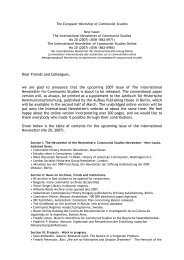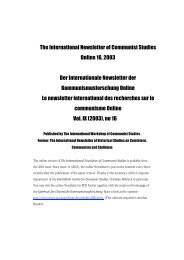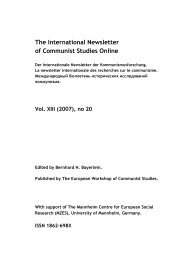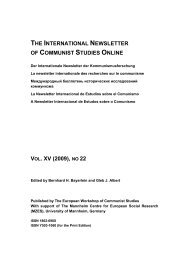VOL. XVI (2010), NO 23 - The International Newsletter of Communist ...
VOL. XVI (2010), NO 23 - The International Newsletter of Communist ...
VOL. XVI (2010), NO 23 - The International Newsletter of Communist ...
Sie wollen auch ein ePaper? Erhöhen Sie die Reichweite Ihrer Titel.
YUMPU macht aus Druck-PDFs automatisch weboptimierte ePaper, die Google liebt.
<strong>The</strong> <strong>International</strong> <strong>Newsletter</strong> <strong>of</strong> <strong>Communist</strong> Studies Online <strong>XVI</strong> (<strong>2010</strong>), no. <strong>23</strong> 147<br />
Stephen A. Smith: Revolution and the People in Russia and China. A<br />
Comparative History, Cambridge e.a., Cambridge University Press, 2008. VIII +<br />
249 p. ISBN 978-0-521-88637-6.<br />
Reviewed by Sobhanlal Datta Gupta, Calcutta<br />
This is a book, comparative in approach and historical in treatment, yet methodologically,<br />
grounded in cultural anthropology. Although this is a case study <strong>of</strong> how the peasants who<br />
settled down in St.Petersburg in 1880-1917 and in Shanghai in 1900-1940s encountered the<br />
complexities <strong>of</strong> modernity under capitalism and subsequently contributed in a unique manner<br />
to the making <strong>of</strong> the two revolutions in China and Russia, a number <strong>of</strong> issues having crucial<br />
sociological implications emerge out <strong>of</strong> the author’s analysis. In the process, Smith has<br />
questioned the validity <strong>of</strong> some <strong>of</strong> the traditional positions on formation <strong>of</strong> working class<br />
consciousness in the making <strong>of</strong> the two revolutions and has come out with new theses on the<br />
basis <strong>of</strong> new findings. <strong>The</strong>se focus on awakening <strong>of</strong> selfhood and identity formation, the<br />
rural-urban interface in the shaping <strong>of</strong> the consciousness <strong>of</strong> the migrants who settled down in<br />
the two aforesaid cities and related issues. Based on primary sources, together with new<br />
studies on this question which have come out in recent years, this is a commendable work<br />
that deserves serious attention <strong>of</strong> all concerned scholars.<br />
<strong>The</strong> study is based on a number <strong>of</strong> premises, which are broadly outlined in the long, very<br />
well-written, scholarly introduction <strong>of</strong> the author. First, while capitalist modernity was<br />
something alien for St. Petersburg as well as Shanghai, it was not a unilinear process <strong>of</strong><br />
Westernization, which generally is considered as equivalent to industrialization. Powerful<br />
resources within the prevalent indigenous traditions in these societies acted as countervailing<br />
forces, shaping thereby the process <strong>of</strong> identity formation (p. 10). Second, while in Russia the<br />
class factor was quite important, in China it was ‘class-inflected’ national identity which<br />
distinguished it from Russia (p. 12). Third, the claims <strong>of</strong> the <strong>Communist</strong> Parties in both<br />
Russia and China that a transformation <strong>of</strong> consciousness had been effected by them is not<br />
much tenable, since the persistence <strong>of</strong> tradition is a factor they had to reckon with. <strong>The</strong><br />
following chapters are illustrative <strong>of</strong> these theses.<br />
In Chapter One the author shows that compared with Russia native place identities were far<br />
stronger in China and this constituted a major impediment to working class unity when the<br />
Chinese <strong>Communist</strong> Party (CCP) stepped in, St. Petersburg and Shanghai being two<br />
contrasting cases. Consequently, while the Bolsheviks in Russia portrayed the Russian<br />
countryside, the abode <strong>of</strong> peasantry, in a negative light, in China the CCP’s attitude towards<br />
the peasantry was s<strong>of</strong>ter, despite its initial scepticism concerning the backwardness <strong>of</strong><br />
China’s countryside. Thus, despite the presence <strong>of</strong> zemliachestva (civic organizational<br />
networks, set up by all parties, but notably by the SRs, the Socialist Revolutionaries, which<br />
sent agitators and propaganda activists to the villages for raising the political consciousness<br />
<strong>of</strong> the peasants) in the Russian villages, which aimed at bonding <strong>of</strong> the workers, soldiers and<br />
the peasants from the same province or country, their significance in the making <strong>of</strong> the<br />
Russian Revolution needs not be overrated, since their organizational strength was no match<br />
for workers’ soviets or factory committees which emerged later. <strong>The</strong> important fact that the<br />
author points out in this context is that all these organizational efforts, despite their uneven<br />
strength, largely facilitated the Russian peasant’s identification with the working class for a<br />
common cause, namely, “the struggle against war, the Provisional Government and for<br />
socialism.” (pp. 60-61).














